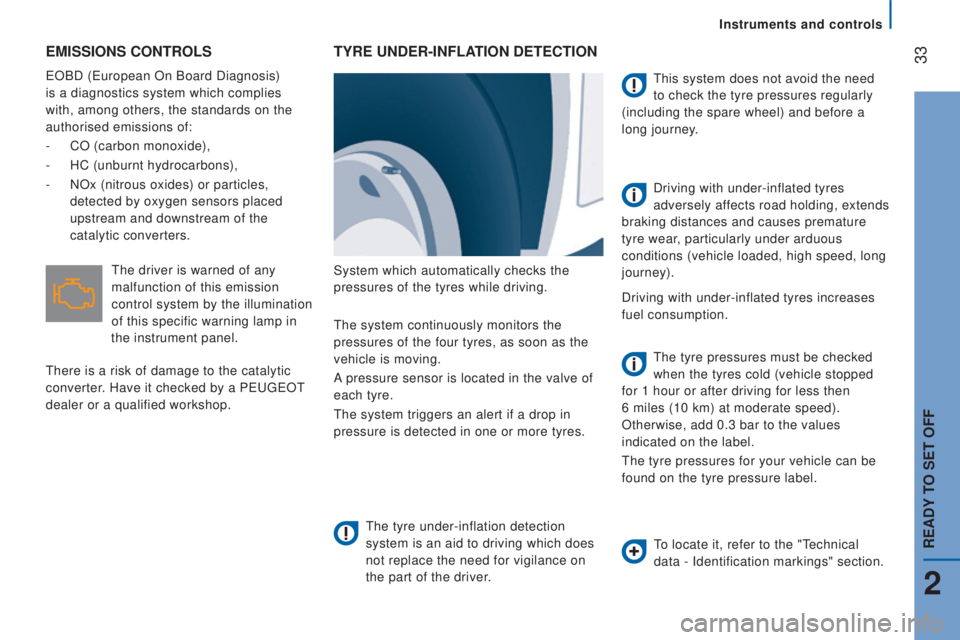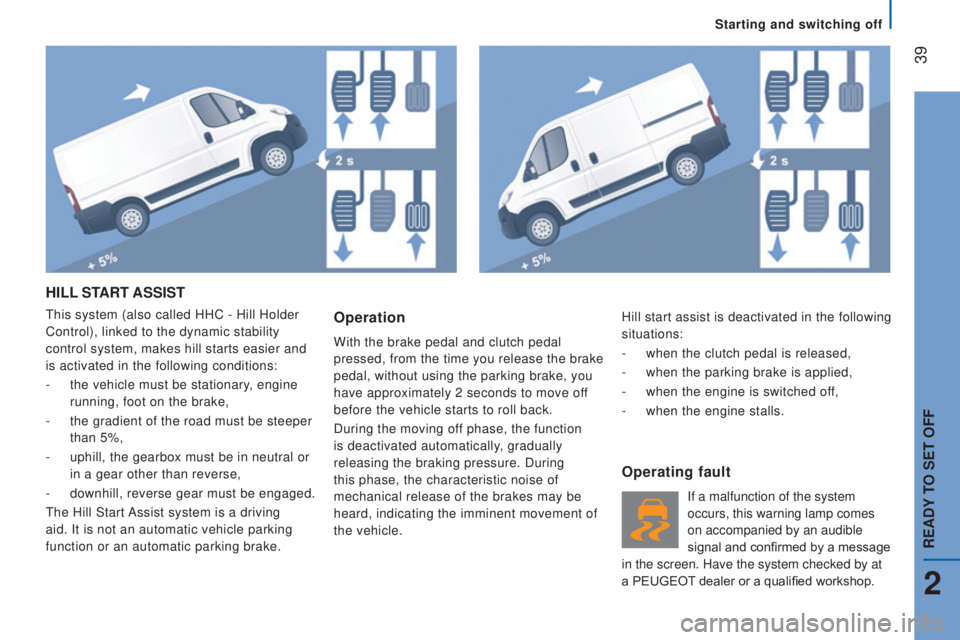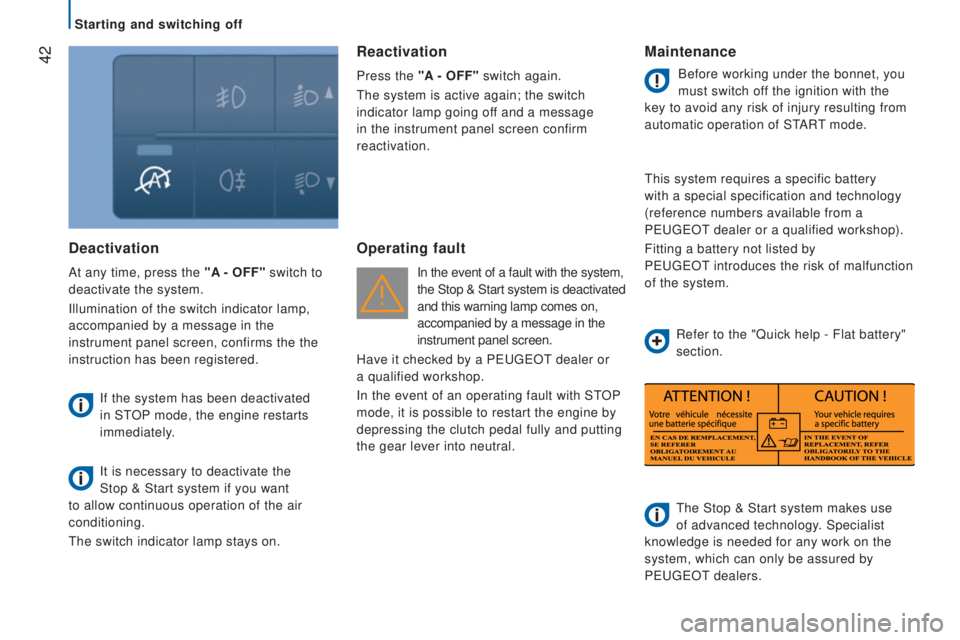2015 PEUGEOT BOXER warning
[x] Cancel search: warningPage 32 of 276

30
Screendisplays indicates Solution - action
temperature /
Ice the ice warning,
the temperature
flashing
accompanied by
a message in
the screen. weather conditions which could
result in ice on the road.
Be particularly vigilant and do not brake sharply.
"Safety - Driving safely".
Date /
time a setting: date,
time. a configuration via the "MODe"
menu. "
technology on board - V
ehicle configuration" section.
Headlamp beam
height a headlamp
height setting.a position from 0 to 3
depending on the load carried Adjust using the buttons on the MOD
e control panel.
"
ease of use and comfort - Steering mounted controls"
section.
Service spanner a service
spanner which
remains on.that a service will soon be due.
Refer to the list of checks in the warranty and
maintenance record, then have the service carried out.
Stop & Start on.
engine going into S
tOP mode
after the the vehicle stops. As soon as you want to move off, the warning lamp
goes off and the engine restarts automatically in S
tARt
mode.
flashes for a few
seconds, then
goes off. S
tOP mode temporarily
unavailable or automatic
operation of S
tARt mode. Special cases for S
tOP mode and StARt mode.
"Ready to set off
- Starting and stopping" section.
Instruments and controls
Page 34 of 276

32
FuEL GAuGE
the fuel level is tested every time the
ignition is turned on.
the gauge is positioned on:
-
F (Full): the fuel tank is full.
-
E (Empty): the reserve is now being
used, the low fuel warning lamp comes
on continuously.
the reserve when the warning first comes
on is approximately:
-
10 litres for 60 and 90 litre tanks,
-
12 litres for 120 litre tanks.
Fuel tanks of different capacities (60 and
120 litres) are available as an option.
cooLAnt tEMPErAturE
the needle is positioned between
c (cold) and H (Hot):
normal operation.
In arduous conditions of use or hot climatic
conditions, the needle may move close to
the red graduations. If the needle enters the red zone or if the
warning lamp comes on:
-
stop immediately, switch of
f the ignition.
the fan may continue to operate for
a certain time up to approximately
10
minutes.
-
wait for the engine to cool down in
order to check the level and top it up if
necessary. Follow this advice:
the cooling system is pressurised. In order
to avoid any risk of scalding, unscrew the
cap by two turns to allow the pressure to
drop.
When the pressure has dropped, check the
level and remove the cap to top-up.
If the needle remains in the red zone,
contact a PeugeOt dealer or a qualified
workshop.
Refer to the "Checks - Fuel" section. Refer to the "Checks - Levels and
checks" section.
Instruments and controls
Page 35 of 276

33EMISSIonS controLS
eOBD (european On Board Diagnosis)
is a diagnostics system which complies
with, among others, the standards on the
authorised emissions of:
-
CO (carbon monoxide),
-
HC (unburnt hydrocarbons),
-
NOx (nitrous oxides) or particles,
detected by oxygen sensors placed
upstream and downstream of the
catalytic converters.
tYrE undEr-InFLAtIon dEtEctIon
System which automatically checks the
pressures of the tyres while driving.
the tyre under-inflation detection
system is an aid to driving which does
not replace the need for vigilance on
the part of the driver.
this system does not avoid the need
to check the tyre pressures regularly
(including the spare wheel) and before a
long journey.
Driving with under-inflated tyres increases
fuel consumption.
the system continuously monitors the
pressures of the four tyres, as soon as the
vehicle is moving.
A pressure sensor is located in the valve of
each tyre.
the system triggers an alert if a drop in
pressure is detected in one or more tyres.
the tyre pressures must be checked
when the tyres cold (vehicle stopped
for 1 hour or after driving for less then
6 miles (10 km) at moderate speed).
Otherwise, add 0.3 bar to the values
indicated on the label.
the tyre pressures for your vehicle can be
found on the tyre pressure label.the driver is warned of any
malfunction of this emission
control system by the illumination
of this specific warning lamp in
the instrument panel.
there is a risk of damage to the catalytic
converter. Have it checked by a P
eugeOt
dealer or a qualified workshop.
to locate it, refer to the "technical
data
- Identification markings" section.
Driving with under-inflated tyres
adversely affects road holding, extends
braking distances and causes premature
tyre wear, particularly under arduous
conditions (vehicle loaded, high speed, long
journey).
2
rEAdY to SEt oFF
Instruments and controls
Page 36 of 276

34under-inflation alert
The alert is given by the fixed
illumination of this warning lamp,
accompanied by an audible signal,
and depending on equipment, the
display of a message.
In the event of a problem on one of the
tyres, the symbol or the message appears,
according to equipment, to identify it.
-
Reduce speed, avoid sudden steering
movements or harsh brake applications.
-
Stop as soon as it is safe to do so.
-
In the event of a puncture, use the
temporary puncture repair kit or the
spare wheel (according to equipment).
-
In the event of under-inflation:
●
if you have a compressor, the one
in the temporary puncture repair
kit for example, check the four tyre
pressures when cold,
or
●
if it is not possible to check the
tyre pressures at the time, drive
carefully at reduced speed and go to
the nearest P
eugeOt dealer or a
qualified workshop.
the loss of pressure detected does not
always lead to visible deformation of
the tyre.
Do not rely on just a visual check.
the alert is maintained until the tyre or
tyres concerned is reinflated, repaired
or replaced.
operating fault
the flashing and then fixed
illumination of this warning lamp
accompanied by the illumination
of the service warning lamp, and
depending on equipment, the display of a
message indicates a fault with the system.
In this case, monitoring of the tyre pressures
is not assured.
this alert is also displayed when one or
more wheels is not fitted with a sensor.
go to a PeugeOt dealer or a qualified
workshop
to have the system checked or
,
following the repair of a puncture, to have
the original wheel, equipped with a sensor,
refitted.
Instruments and controls
Page 37 of 276

35SErVIcE IndIcAtor
For a few seconds after the ignition is
switched on, the spanner symbolising the
service indicator comes on: the screen
informs you when the next service is due,
in accordance with the servicing schedule
indicated in the warranty and maintenance
record.
this information is determined in
relation to the distance travelled since the
previous service.
After a few seconds, the display returns to
its usual functions. A long press returns you to the main menu.
Refer to the "
technology on board -
V
ehicle configuration" section.
deterioration of the engine oil
Refer to the list of checks in the
warranty and maintenance record
which was given to you on handover of
the vehicle.
reminder of servicing information
At any time, to access the service indicator,
press briefly on the M
odE
button.
use the up/down arrows to see the
scheduling and engine oil wear information.
Pressing the M
odE
button again allows you
to return to the various display menus.
Menu...
choose...Allows you to...
11
Service Service
(miles/
km before
service)
Display the
distance
remaining
before the
next service.
Oil (miles/
km before
oil change) Display
the miles/
kilometres to
the next oil
change.
resetting to zero
the continuous flashing of the indicator is
stopped by a qualified workshop using a
diagnostic tool.
this 2nd warning lamp, coupled
with the 1st, comes on in the
instrument panel when the oil
has not been changed and the
deterioration of the oil has reached another
threshold.
to avoid the risk of damage, have
the oil changed without waiting for this level.
the warning lamp flashing and,
if your vehicle has the function,
a message displayed at every
engine start: the system has
detected deterioration of the engine oil.
Have the oil changed as soon as possible.
For 3.0 litre HDi engines, the engine speed
is restricted to 3 000 rpm, then 1 500 rpm
until the oil change is done. Have the engine
oil changed to avoid any risk of damage.
2
rEAdY to SEt oFF
Instruments and controls
Page 40 of 276

38
IGnItIon SWItcH
StoP position: steering lock.
the ignition is of
f.
MA
r position: ignition on.
Certain accessories can be used.
AV
V position: starter.
the starter is operated.
Starting the engine
Engine immobiliser warning lamp
If this warning lamp comes
on, use another key and have
the faulty key checked by a
P
eugeOt dealer.
diesel pre-heating warning lamp
With the parking brake applied
and the gearbox in neutral, turn
the key to the MA
r position.
W
ait for this warning lamp to go off then
operate the starter (AV V position) until the
engine starts.
the period of illumination of the warning
lamp depends on the climatic conditions.
door or bonnet open warning lamp
If this warning lamp comes on,
check that the doors and bonnet
are closed correctly.
Switching off the engine
Stop the vehicle and apply the parking
brake, then, with the engine at idle, return
the key to the S
t
o
P
position.
In low temperatures
In mountainous and/or cold areas, it is
advisable to use a "winter" type fuel suited
to low or minus temperatures.
Avoid attaching heavy objects to the
key or the remote control, which would
weigh down on its blade in the ignition
switch and could cause a malfunction.
It could adversely affect the deployment of
the front airbag. With the engine hot, the warning lamp comes
on for a few moments, you can start the engine
without waiting.
As soon as the engine is running, release the key.
Starting and switching off
Page 41 of 276

39
HILL StArt ASSISt
this system (also called HHC - Hill Holder
Control), linked to the dynamic stability
control system, makes hill starts easier and
is activated in the following conditions:
-
the vehicle must be stationary, engine
running, foot on the brake,
-
the gradient of the road must be steeper
than 5%,
-
uphill, the gearbox must be in neutral or
in a gear other than reverse,
-
downhill, reverse gear must be engaged.
the Hill Start
Assist system is a driving
aid. It is not an automatic vehicle parking
function or an automatic parking brake.operation
With the brake pedal and clutch pedal
pressed, from the time you release the brake
pedal, without using the parking brake, you
have approximately 2 seconds to move off
before the vehicle starts to roll back.
During the moving off phase, the function
is deactivated automatically, gradually
releasing the braking pressure. During
this phase, the characteristic noise of
mechanical release of the brakes may be
heard, indicating the imminent movement of
the vehicle.
operating fault
If a malfunction of the system
occurs, this warning lamp comes
on accompanied by an audible
signal and confirmed by a message
in the screen. Have the system checked by at
a PEUGEOT dealer or a qualified workshop. Hill start assist is deactivated in the following
situations:
-
when the clutch pedal is released,
-
when the parking brake is applied,
-
when the engine is switched off,
-
when the engine stalls.
2
rEAdY to SEt oFF
Starting and switching off
Page 44 of 276

42
deactivation
At any time, press the "A - oFF" switch to
deactivate the system.
Illumination of the switch indicator lamp,
accompanied by a message in the
instrument panel screen, confirms the the
instruction has been registered.
If the system has been deactivated
in S
tOP mode, the engine restarts
immediately.
It is necessary to deactivate the
Stop
& Start system if you want
to allow continuous operation of the air
conditioning.
the switch indicator lamp stays on.
reactivation
Press the "A - oFF" switch again.
the system is active again; the switch
indicator lamp going off and a message
in the instrument panel screen confirm
reactivation.
operating fault
In the event of a fault with the system,
the Stop & Start system is deactivated
and this warning lamp comes on,
accompanied by a message in the
instrument panel screen.
Have it checked by a P
eugeOt dealer or
a
qualified workshop.
In the event of an operating fault with S
tOP
mode, it is possible to restart the engine by
depressing the clutch pedal fully and putting
the gear lever into neutral.
Maintenance
Before working under the bonnet, you
must switch off the ignition with the
key to avoid any risk of injury resulting from
automatic operation of S
tARt mode.
this system requires a specific battery
with a special specification and technology
(reference numbers available from a
P
eugeOt dealer or a qualified workshop).
Fitting a battery not listed by
P
eugeOt
introduces the risk of malfunction
of the system.
the Stop & Start system makes use
of advanced technology. Specialist
knowledge is needed for any work on the
system, which can only be assured by
P
eugeOt dealers.
Refer to the "Quick help - Flat battery"
section.
Starting and switching off